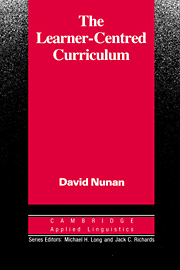Book contents
- Frontmatter
- Contents
- Series Editors' Preface
- Preface
- 1 Introduction
- 2 Curriculum Processes
- 3 Learner-Centred Curriculum Development
- 4 Pre-Course Planning Procedures
- 5 Planning Content
- 6 Methodology
- 7 Resources for a Learner-Centred Curriculum
- 8 Assessment and Evaluation
- 9 Evaluation and Professional Development
- 10 The Teacher as Curriculum Developer
- References
- Appendix
- Subject Index
- Author Index
3 - Learner-Centred Curriculum Development
Published online by Cambridge University Press: 05 April 2013
- Frontmatter
- Contents
- Series Editors' Preface
- Preface
- 1 Introduction
- 2 Curriculum Processes
- 3 Learner-Centred Curriculum Development
- 4 Pre-Course Planning Procedures
- 5 Planning Content
- 6 Methodology
- 7 Resources for a Learner-Centred Curriculum
- 8 Assessment and Evaluation
- 9 Evaluation and Professional Development
- 10 The Teacher as Curriculum Developer
- References
- Appendix
- Subject Index
- Author Index
Summary
Introduction
One way of typifying curriculum models is in the degree to which they allow curriculum development to occur at the local level. A fully centralised curriculum, as the name suggests, is one which is devised in a centralised location and then disseminated (this is sometimes known as the centre-periphery model for obvious reasons). Many school curricula developed during the 1950s and 1960s accorded with this centralised model. They were often produced by a government department or agency, and then disseminated to a wide range of learning institutions. The responsibility of the teacher in such systems was often little more than to implement the curriculum and to act as ‘classroom manager’. An example of a centralised approach to language teaching is the Situational English course which was developed for teaching ESL in Australia during the 1960s and early 1970s. During this time, it was possible to go into language classrooms all over the country and find a similar curriculum in place for teaching a wide range of learners. In those days the only criteria for differentiating learners was level of proficiency.
During the 1960s, the relative inflexibility of centralised curricula, and a change in educational thinking which paid more attention to the learner, led to the ‘school-based’ curriculum development movement. School-based curricula are devised either wholly or in part within the teaching institution itself. Such curricula are capable of being much more responsive than centralised curricula to the needs and interests of the learners they serve. The learner-centred movement in ESL/EFL is partly an offspring of the school-based curriculum movement.
- Type
- Chapter
- Information
- The Learner-Centred CurriculumA Study in Second Language Teaching, pp. 21 - 41Publisher: Cambridge University PressPrint publication year: 1988



